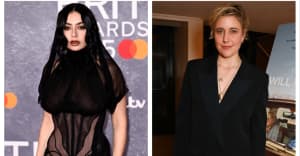 Olivia Rodrigo
Disney+
Olivia Rodrigo
Disney+
Pop documentaries are almost always marketed on the allure of proximity – allowing the viewer the privilege of being up close and personal with an artist despite that intimate feeling often being crafted within a space that still holds the audience at an arm’s length. In the new Disney+ documentary-concert film Driving Home 2 U, Olivia Rodrigo looks back on the making of her debut album Sour through in-studio footage captured on a GoPro tucked in the Los Angeles studio where she wrote and recorded the album with producer Dan Nigro. The footage is woven together with performances reimagining the tracklist in chronological order of when each song was created. Mostly, her commentary is provided through the lens of hindsight as she sifts carefully through memories of the time. Throughout the film, the 19-year-old singer and songwriter holds her cards close to her chest – neatly circumventing the who, what, why, and how of the record’s rumored subject matter.
In one scene, about an hour into the film, Rodrigo recalls the nerves that rocked her as she was thrown into the spotlight nearly overnight. “I remember just feeling kind of trapped and kind of, like, flung into this situation that I wasn’t prepared for,” she says in a voiceover. “All of a sudden, everyone’s watching you, and I’m like, ‘Oh my God,’ Did I actually ever want this?” It’s one of the few moments that creates a genuine feeling of intimacy, but Driving Home 2 U is intent on painting a portrait of an artist who is most accessible through song. Listening to Sour will tell you more about the singer than anything she’ll reveal to a camera. For Rodrigo to establish that limited accessibility at such an early stage of her career feels strategic in maintaining control of her own public narrative – taking a card from Taylor Swift, who redrew the lines of her own boundaries in the 2020 documentary Miss Americana.
The documentary format is inherently self-serving in that way – and timing is key. The Apple TV+ film Billie Eilish: The World's a Little Blurry similarly captures the making of the singer’s historic debut album. The film offered up far more about Eilish’s self-reflection and personal relationships and, most importantly, how those two elements inform her creative process. Meanwhile, BLACKPINK’s Netflix release Light Up The Sky is committed to presenting the four-piece girl group as undeniable stars. It follows them from their days as K-Pop trainees all the way to Coachella, but the peculiar and overbearing presence of their record producer Teddy Park threatens to darken the film’s shine.
The recent onslaught of pop music documentaries released in the past few years share a common thread in their attempt to wrangle back a sense of understanding, or control, years after their muddled narrative has taken form as something largely unrecognizable. There’s a sense of trust and proximity crafted through the draw of exclusive, never-before-seen archival footage, either shared on the artist’s own careful volition or by an insider operating close enough to them to capture raw, unfiltered material with ease of access. Often condensing decades of personal development into just a few hours, as films or brief series, how do these documentaries effectively reclaim the ever-shifting narratives of their subjects, if they can at all?
In the Netflix documentary series Jeen-Yuhs: A Kanye Trilogy, directors Clarence ‘Coodie’ Simmons and Chike Ozah stumble their way towards an answer. Across four-and-a-half total hours, crafted from a goldmine of over 330 hours of archival footage captured over 21 years, the directing duo chronicles Kanye West’s transformation from rising Chicago rapper – one with unrelenting determination – to volatile cultural figure. The series puts into context how badly he wanted to become an invaluable, influence-wielding star, how he made it happen, and how he unraveled along the way. How do you nail down an artist who considers himself to be perpetually misunderstood and refuses to move at anything below full speed? It seems that after a certain point, you can’t.
For the better part of his career, West has been something of a moving target. Jeen-Yuhs itself arrived in the midst of a shift. In the weeks before its arrival, the rapper took aim at Kim Kardashian, Pete Davidson, and Billie Eilish on Instagram – a few of his many chaotic, and highly public, implosions on the app as of late. “I miss the old Kanye” has been a running gag for some years now, but even Simmons shuts the camera off when he catches up with West during his failed presidential campaign and realizes the dynamic they established 20 years prior has shifted entirely. “I never shot that side of Kanye,” the director told BBC Radio 1Xtra. “It just felt uncomfortable.” Simmons and Ozah declined West’s very public demand for final edit and approval of the docuseries on the grounds that “for it to resonate, people need to see certain things.” And yet, large stretches of the final two-thirds of the trilogy are padded with filler that has nothing to do with the rapper.
As a filmmaker, maybe it’s better to have an instinct for when to stop filming than for your subject to have to tell you to cut the cameras, but the thought process that plays into that decision is heavily informed by the relationship between the people in front of and behind the camera. When Charli XCX filmed her documentary Alone Together in quarantine, she and her housemates controlled when shooting stopped and started. Its directors, Bradley Bell and Pablo Jones-Soler, crafted the film out of the footage they received at the end of each day. Had they been physically present, maybe they would have kept the cameras rolling when the singer called for a timeout. Maybe that captured moment of emotional vulnerability wouldn’t have made it into the film, anyway. But as an artist who is more online than most, Charli’s threshold for how much she’s willing to share shapes not only what we see in the documentary but also the hard-drawn lines of what we don’t.
The conversations withheld from these films and series are often as telling as the ones that are included. It returns to this notion of wanting to create something in line with the artist’s narrative, whether ongoing or in the process of being reconstructed. There’s a crucial grain-of-salt element involved for the audience, especially for YouTube docu-series like Demi Lovato’s breathtakingly vulnerable Dancing With the Devil or Justin Bieber’s revealing Seasons. Both were heavily shaped by manager Scooter Braun, and consequently stained with an oddly promotional feel, like a neatly concluded victory lap just in time for the album to drop.
There’s something to be said about allowing those stories to be told by the right people in their own time. In the four-part documentary series Janet Jackson, the pop icon regains control on her own terms and in her own words. When her ex-husband René Elizondo, who filmed countless hours of the singer’s private and public life over the course of their 10-year marriage, attempts to stage an embrace between Jackson and her mother, she pulls the plug. When a studio session with Jimmy Jam sparks creative strife, she matches his energy with the force of her own. When it comes time to talk about the more controversial elements of her brother Michael’s life, she treads carefully, fighting to keep her story at the center. Filmed over the course of five years, the series builds around the exclusive insight and commentary that couldn’t be found anywhere else.
This is her narrative she’s writing here, but it wouldn’t be complete without an addressing of the infamous 2004 Super Bowl half-time show. She moves on from it quickly – the series begins to crumble in the latter half without Elizondo’s archival footage – but not without first revealing that she had advised Justin Timberlake not to make a statement about the incident: “If I were you, I wouldn’t say anything.” The two artist’s stories became perpetually intertwined from that moment on, but it was only Jackson who was essentially blacklisted from the entertainment industry. When she was invited back to perform with Timberlake in 2018, she declined. She wouldn’t allow his role in her narrative to inflate once again, after she had spent years letting it die out. Jackson's guiding hand throughout the series is unwavering in its desired external perception.
Unfortunately for him, Timberlake is a notorious figure in another one of pop’s biggest fights to regain control, though Britney Spears hasn’t yet been able to tell that story on her own. While the singer fought to bring an end to the restrictive conservatorship she had been kept in for 13 years, she became the center of two major documentaries – the New York Times-presented double-feature Framing Britney Spears and Controlling Britney Spears – examining how she ended up there. The creators of both films got as close to the singer as they could manage without her direct involvement, painting a compelling portrait of an artist driven to disillusion as the public callously stripped her of any agency. But seeing the two films put into conversation with the singer’s own statements shared in court, leading up to the conservatorship termination, it’s hard to decipher the feeling of irony in the story of her freedom being shared before she could reclaim the narrative herself.
Pop documentaries become a double-edged sword when the reputation of objective and independent documentary filmmaking intersects with the rightful authority of an artist – or the teams of executive producing-industry figures who derive benefit from holding the reins of their image. There are rarely ever clear answers to the questions of agency and intention that color the purpose they serve for both their audience and their subject. And yet, for all of these artists, their stories are not yet complete. All that we learn from those particular moments in time captured on camera informs the living document of their personal and artistic narrative.
It’s human nature to platform the best parts of ourselves and keep the less polished parts tucked away as a form of self-protection. But ideally, these films should be approaching a balance between the two – not because we as an audience are entitled to the privilege of being welcomed into the good and the bad, but because the most authentic approach recognizes that both are essential to establishing meaningful complexities.


